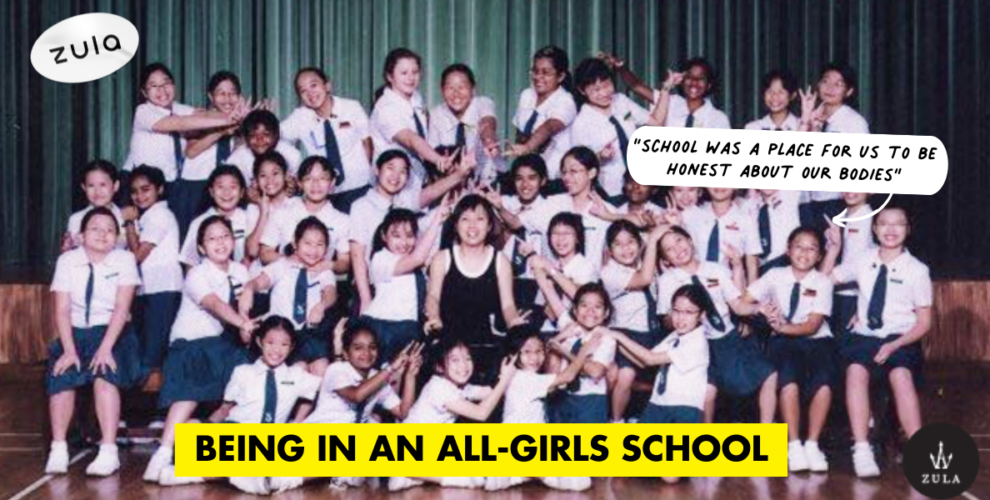Girls’ School Education
Previously, The Straits Times published a forum letter that claimed same-sex schools didn’t prepare kids for life.
Coming from an all-girls school myself, I was incensed.
People who come from single-sex schools tend to have a certain pride and possessiveness over our experience. If someone told us it was bad for us, we’d usually fight tooth and nail to prove them wrong.
Thus, I was ready to retaliate, but not before seriously considering the validity of the writer’s concerns.
I thought hard. I really did. But when I looked back at my past eight years of life post-secondary school, it became obvious my all-girls school education was one of the best things that happened to me.
Who Run The World?
Often, my friends and I joke if you see a woman making her boyfriend or husband holding her handbag, she definitely didn’t come from an all-girls school.
Although it’s a generalisation, I’d like to believe there’s some truth to that.
Since there were only girls around, teachers couldn’t assign the heavy-lifting to boys. If a teacher needed help with a huge box of files, two girls would do it. And if a tiny girl was struggling under the weight of her school bag to get to her classroom on the top floor, she took a break halfway through the climb.
Once, a schoolmate collapsed during the middle of assembly. Before a teacher could come to her aid, a classmate single-handedly hoisted her out of the hall.
Because we had to depend on ourselves, we rose to the challenge every time.
Whether male or female, every child should be encouraged to be self-reliant. I think my all-girls school education did that exceptionally well.
Body Talk
School was a place for us to be honest about things which were happening to our bodies. As a result, we were never shy or apologetic about our girl parts.
It’s widely known that girls from single-sex schools have virtually no boundaries when talking about their reproductive organs and bodily functions.
Everyone cramped, everyone bled. If someone needed a pad, we’d throw them one from across the classroom. If something itched or hurt, we could talk about it and nobody would cringe.
When I went on to tertiary education, I was baffled when I saw girls whispering to each other and slipping pads between their palms.
Their explanation was “there were boys around”. I could not fathom how menstruation—a natural process that happens to 50% of the population—was something to be kept secret.
Later, I’d find out from my guy friends that many girls they’d been with felt uncomfortable receiving oral sex, but were fine with giving it.
Apparently, the girls were insecure about how they looked, smelled and tasted, though their partners were more than willing to ‘get down to business’.
It was only then I realised how much those candid conversations in secondary school shielded me from social stigma about the female body.
Growing up, I was never made to feel uncomfortable and dirty about owning or bleeding from my vagina. As a result, I had a healthy view of what my body did and felt.
While I’m not saying that girls from mixed-sex schools can’t form positive relationships with their womanhood and sexuality, I believe that my all-girls school education made it much easier for me to do so.
Also read:
Sky’s the Limit
Even though they aren’t explicitly mentioned, we have gendered assumptions of certain occupations.
Mention “engineer” or “CEO” and your mind conjures up the image of a man. Say “nurse” or “teacher” and you’d think of a woman.
Before I was made aware of these gender disparities in society, a single-sex environment gave me the chance to develop my aptitude in the sciences or the arts without being bogged down by these expectations.
We took lessons in Design and Technology and Home Economics. Some girls were better at cutting acrylic than raw chicken. We were also never taught to sew, so our husbands will have to patch their own pants.
More importantly, being in an all-girls school meant we took up leadership roles without the fear of being called bossy.
With men out of the equation during our formative years, we experienced what it was like to pursue the roles we wanted without the infamous glass ceiling we’d inevitably have to deal with later in life.
House captains, CCA presidents and student conductors didn’t stand out because they were “women in a man’s world”. They were simply noticed if they were good.
My time in an all-girls school showed me that despite the prevailing negative stereotypes, good female leaders can shine if a system exists to support them.
Haters Gonna Hate
Being around hormone-filled girls honestly wasn’t the most peaceful experience, but it toughened me up for the ultimate bitch: life.
The way I see it, my years in an all-girls school allowed me to really focus on the things that mattered to me—my studies and my passion for dance. Not having boys flinging stapler bullets at my head or professing their love for me was ideal in those circumstances.
Lastly, some people say kids from single-sex schools have problems interacting with members of the opposite sex.
When I look at my friends now, I see strong and independent women who are in no way socially-inept.
And judging by the rate my secondary school friends are getting married, I don’t think we have an issue at all.
This post was first published by Chloe Tong on 4 December 2017 and last updated by Nicole Yong on 17 September 2023.
Also read:
There’s No Valentine’s Day Like A Girls’ School Valentine’s Day










